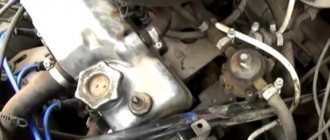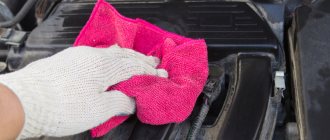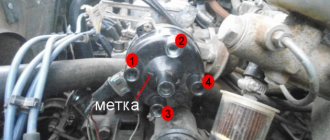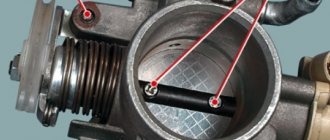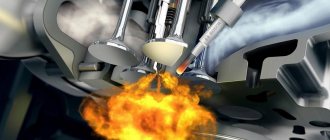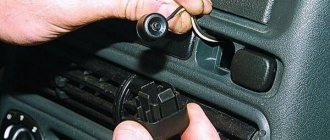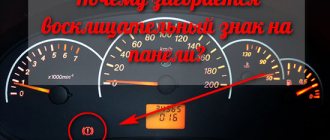There are a great many reasons why the engine does not show signs of life, and sometimes one problem leads to another, and it is immediately difficult to figure out why the car has turned into real estate. We will analyze the most common reasons without touching on the nuances.
Starter.
The starter is a small electric motor that supplies the crankshaft with the torque needed to ignite the fuel.
If after turning the key (or pressing the engine start button) nothing happens or uncharacteristic clicks are heard, then most likely the problem is in the starter. Sometimes it starts working only after several unsuccessful attempts to turn the key, or it turns the engine very slowly, although the battery is charged.
The reasons why the car does not start in this case can be different: from wear of brushes or bearings to oxidized contacts and shorted wiring. On site, you can only check the contacts from the battery, and the battery itself - maybe it is faulty. The rest is best left to specialists. The cost of repair depends on what happened to the starter. It may be possible to repair it or it may have to be replaced entirely.
Generator or battery.
In a nutshell, a generator is a device that converts part of the engine energy into accumulated battery charge. A faulty alternator does not charge (or does not charge enough) the battery, which does not have enough charge to turn the starter. An old battery does not hold a charge well and discharges quickly, especially in cold weather. Usually the problem is one thing at a time.
The battery may be discharged to zero and then the starter will not spin and the instrument panel will not turn on. If there is still voltage, the car will warn you about the low battery with an icon on the instrument panel. The car may start after being “lighted” by another, but you will feel that the generator is charging the battery at half capacity and after parking there is no “current” in the car again.
If the generator breaks down, then the only way is to service. By the way, check the alternator belt if you know where it is located. Perhaps that's the problem. If you see that it has been torn off, order a tow truck. In modern engines, the cooling system operates on this belt and the engine can overheat if you drive under your own power. You can replace the old battery yourself, after first checking the reliability of the contacts on the terminals and the wire line from the generator to the battery.
Spark plug.
The engine may not start due to deposits on the spark plugs, causing them to work incorrectly or not spark at all. This usually happens due to the fault of poor quality fuel. Other options: wear of the electrode or spark plug connector.
Fuel supply system.
The fuel pump may be faulty - burnt out or there are problems with the wiring. By itself, this device rarely breaks down. More often this happens due to the habit of driving “in steam”, filling the tank with the minimum amount. Fuel pumps cool down, “bathing” in fuel, and if there is not enough fuel, they overheat and wear out.
Another reason: the fuel hose is damaged. In this case, the car usually smells like fuel. Sometimes the fuel filter is very clogged, which ceases to be a filter element and turns into a plug.
ECU.
The electronic engine control unit may be faulty, making it impossible to start the engine. This often happens when the ECU box is corroded and the contacts on the board inside are damaged. In some car models, the control unit is structurally poorly located. It begins to rust after a couple of years of use, and then problems begin with starting the engine. The only way to help your car is to take it to a service center for a check. Here we also add problems with the alarm system, which can block the car due to some error.
Since a car is a complex device consisting of many elements, there can be a great many weak points.
We list other possible problems due to which the car may not start:
- insufficient pressure in the cylinders;
- leakage of ignition wires;
- faulty crankshaft, camshaft, idle, oxygen position sensors;
- problems with the timing chain or belt;
- ignition coil malfunction;
- either the fuel simply ran out and you didn’t notice, or the fuel level indicator is lying.
There is no fuel in the car
This is the most common problem faced by millions of car enthusiasts. The fuel level is the first thing you should check, no matter how funny it may sound. After all, you may well not have noticed that the car’s fuel level is at zero. Yes, it may look stupid, but believe me, very often this is the reason the engine fails to start. So if this happens to you, go to the gas station. Here is a simple solution to the problem.
The crankshaft turns, but the engine does not start
The starter turns, but the engine cannot start. Basic situations:
- the engine does not start at normal temperature;
- winter launch;
- starting the engine “hot”.
The table shows possible reasons.
| Malfunction | Type of internal combustion engine (ICE) | ||
| Carburetor | Injector | Diesel | |
| Fuel pump malfunction | + | + | |
| Malfunction of the high pressure fuel pump (HPF) | + | ||
| Low fuel level in the float chamber | + | ||
| Insufficient pressure in the fuel rail | + | ||
| The injectors are clogged | + | + | |
| Air filter clogged | + | + | + |
| Current leakage from high-voltage coils or wires | + | + | |
| Spark plugs don't work | + | + | |
| Start blocking by the immobilizer in the event of a malfunction of the electronic control unit (ECU) | + | + | |
| Insufficient compression in engine cylinders | + | + | + |
All failures can be grouped into 5 groups:
- lack or shortage of fuel;
- air starvation;
- the spark is gone;
- low compression;
- control failure.
The clamps of the high-voltage wires are loose
The second most common reason for the engine not starting is poor contacts of high-voltage wires with the battery terminals. This occurs due to the fact that the clamps of the high-voltage wires have become loose. So if your car won't start, open the hood and check the tightness of the terminals and their condition. If there is oxidation on them, clean the terminals and then try turning the ignition on again. By the way, the first sign that the terminals have poor contact due to poor tightening is oxidation on them.
Looking for a spark
If there are problems in the ignition system, the engine sometimes seizes, but does not start. On a carburetor engine, you can check the presence of voltage on the spark plugs using the “breakdown” method. Having removed the wire from the tip of the spark plug, unscrew it from the cylinder head cover. Then we put the wire on it again, place it on any metal surface (as long as there are no gasoline drips nearby) and turn on the starter.
A spark discharge between the central and side electrodes indicates the serviceability of the spark plug. If there is no discharge, we check whether there is voltage on the high-voltage wires, the ignition coil, by bringing the end of the tested wire to ground. In this way we find the source of the malfunction in the ignition system.
Attention: such actions cannot be performed on engines with a controller (injection and diesel) to avoid damage to the ECU.
In this case, there is only one option left: to monitor the presence of voltage using a diagnostic device - a tester. It can be used to check all electrical components of the ignition system electrical circuit.
Battery contacts are dirty
If you see some kind of whitish, greenish tint around the battery terminals, then the connection of the high voltage wires to the battery may be weak. Carefully remove the clips from the battery (plate is acidic) and clean the battery terminals with a suitable tool (such as a metal cleaning brush). If you don't have a tool handy, try tapping each battery terminal with a car key of some kind to knock some dirt and residue off the contacts. Then repeat the engine starting process again.
Low rail pressure
The engine starts the second time if the pressure on the fuel rail is too low and the boost injection cannot ensure a normal fuel supply. Before starting, the fuel pump takes time to rise. Different pumps show different pressures, but a new one should have about 6 atm. A pressure of 5 atm indicates severe wear, and a pressure of 4.0 atm is already a cause for concern.
A non-working pump can be recognized by ear: there is no characteristic buzzing sound during starter operation. In the best case, a bad contact in the electrical circuit is to blame, and in the worst case, the pump needs to be replaced.
If the fuel pump is working properly, and the pressure in the rail either drops or is restored: this is due to a leak in the fuel pressure regulator. When replacing it, the functionality of the gasoline supply system will be restored.
Why is “burnt” butter dangerous? Defective products destroy motors Read more
The battery is dead
So, have you checked the high voltage wire clamps, battery terminals and found nothing? Still don't know why your car won't start? Your car's battery is probably dead. If you have wires for "lighting up", you can find another motorist who will agree to help you "light up" your car. If your car was started by another car, have your car's battery diagnosed by a mechanic. It may be time to get a new battery.
Frost, the engine won’t start: what to do?
When the engine does not come to life in extreme cold, it is too late to bite your elbows for not taking care of the condition of the battery and changing the oil according to the season. What can you do at -30°C right next to the hood? What is the last chance to give the motor?
And yet, let’s say a few words about “AKB and SAE”. If the battery does not start the engine with a kick even in light frosts, or even more so in a heated garage, then there is nothing to blame if it does not crank the crankshaft when it really gets stuck outside. The viscosity of the oil, corresponding to your winter, is still a key factor. If the dipstick does not drip, but drags, or there is no longer any movement on it, it is better to completely forget about trying to revive the engine, so to speak, “naturally.” A possible start-up may result in dry operation and, accordingly, a major overhaul.
Why else might the engine not start?
- Candles with an expired life, that is, with larger gaps than necessary and traces of breakdowns on the insulator;
- The pump and injectors do not provide high-quality fuel atomization;
- Current leaks through cracks in high-voltage wires, condition of ignition coils;
- Poor condition of the CPG, that is, low compression;
- Dirty air filter, which creates intake resistance;
- Typical mode of operation of a traveling vehicle: short trips and frequent stops, when the battery charge is constantly consumed by the starting current and does not have time to be replenished;
- On cars with an autonomous preheater, this “stove” can suck all the energy from the battery, which is then not enough to start.
Of course, you should not completely discount the peculiar firmware of the engine control units of some cars. In order to comply with strict environmental standards, they do not have a so-called warm-up mode with an enriched fuel mixture. But this applies mainly to models for European and other markets, where there is no frost and obviously high-quality fuel. There are rare exceptions. One of the recent examples is the Renault Kaptur with a 2.0-liter engine, which last season refused to start at −25°C (the software has since been updated). Another example: some not new Honda engines (say, F23), which do not grip even at 0 degrees.
Basically, the reluctance to start is due to the reasons mentioned above regarding operation and maintenance. Moreover, all but the last two can make starting difficult even at positive temperatures.
And finally, you can’t be 100% sure of the quality of the fuel. Despite the fact that it is growing, there are still enough “samovars” in the country. Yes, and in large networks it can “float”. If all maintenance rules are followed, it is the fuel that can become a stumbling block during low-temperature starting.
Let's let it in - don't burn, don't flood
The launch rules have long been spelled out in detail. First, to warm up the battery, turn on the low beam for 10–15 seconds, and you also need the pump to pump up the fuel. On some cars (for example, right-hand drive), the low beam can be turned on when the key is turned to the first click (ACC position), but in this case you must remember that the pump will turn on only when the key is turned to the ON position - that is, “ignition” (wait 3-5 seconds before turning on the starter). Next, the actual start - cranking with the starter for the same 10-15 seconds. If the engine does not start, take a break for two to three minutes and try again. How many of them can you make? Usually two to four.
Breaks between attempts are necessary to cool the starter. Particularly stubborn car owners who push it to the bitter end, then call a tow truck. Bring the winding to the condition as in the photo
When there are flares on some cylinders, you can try turning them some more. More often, after this, it must be stated that the candles have been filled with gasoline. At the same time, the battery also died.
The basic principles of “lighting a cigarette” are simple. For example, in the operating instructions for the Ford Focus they are formulated as follows:
1. Stop the donor engine. 2. Connect the plus to the plus, and the minus of the “donor” not to the minus of the “recipient”, but to the grounding pin under the hood. (It is strictly indicated - “not to minus!”. If “to minus”, there is a risk of damaging the battery. But no matter how much they did it in practice, everything was fine - author’s note). 3. Start the donor engine. 4. Start the “recipient” engine. 5. Let both machines run for three minutes and only then disconnect the wires.
The cross-section of the wires for “lighting” should not be 4–6 mm² (which is usually found on Chinese goods), but 4–6 times larger. Otherwise, you will “heat” the street and not start your engine
There is an opinion that if the “donor” is an expensive modern car, then to protect its complex electronics it will be better if the engine is turned off at the moment of “lighting up”, or if the engine is running, all energy consumers should be turned on to the maximum. It is difficult to provide any statistics, but familiar electricians say that after “lighting up” cars are periodically brought in with faulty units.
By the way, the barbaric method of “installing a fresh battery, starting it on it and then returning the old one directly with the engine running” requires the load on the network of your car. This is acceptable with older models that do not have numerous control units. But even in this case, everything may go wrong - the fuses or ECU will blow out.
Important: “lighting” not from another car, but from the so-called launcher (starting device, booster), you need to be even more careful. It’s not for nothing that auto electricians call it a “stupid machine.” If this is an extreme case, then you can use such means, but it is better to use this method on ancient models. Modern ones can burn a lot of things.
Of course, “lighting” in this situation is only a passing operation (because they twisted it and landed it). The combustion chambers must be ventilated. Sometimes the purge mode helps, when at the moment of starting the gas pedal is pressed all the way, which is why fuel is not injected. This is not possible on all models. It is safer to unscrew the spark plugs, turn off the fuel supply and ventilate the cylinders with the same starter (note that for a simple motorist the task of turning off the fuel supply may not be trivial; for modern “complex” cars it is better to immediately use a heat gun or a tow truck). Then put everything together and... It’s not a fact that it will start.
Heat or inject?
Fuel has such a characteristic - saturated vapor pressure, which determines its ability to evaporate and, in fact, ignite. As the temperature drops, it decreases - until the moment when starting the engine becomes impossible.
To exclude this, you can go in two ways. The first is to create conditions under which fuel evaporation would occur. Simply raise the temperature in the intake manifold. Doing this with your own hands is problematic. Someone swears: they say they put bottles of boiling water on the manifold and then started it. Still, this method seems ineffective. However, if you create additional favorable conditions (have several containers on hand, cover them along with the duct with heat-insulating material), then you can try. But pouring boiling water onto the collector, even through a rag, which is supposed to prevent splashing, is fraught. How many cases have there been when the belt jumped due to ice formed on the timing gears! In many cars starting from 2000, the plastic manifold may not withstand such a thermal shock. Not to mention the fact that the entire compartment will be “filled with ice.”
Let’s not talk about the blowtorch and coals from the stove here. Nowadays in the city this is as important as improving the low-temperature viscosity of oil by adding gasoline to it.
The second option is to replace automobile fuel with more volatile substances that are injected into the intake tract. We are talking about ether-based starting mixtures, which are available in the range of many oil and auto chemical manufacturers, including, for example, such a respected one as Liqui Moly. It looks like you can use it, but be very careful. And the load on the piston group is high (shock), and you can tear the air filter along with its duct and the intake manifold. Such cases are known.
SOS: safe, but expensive?
Another way is to refer to . It's actually not as expensive as it might seem. A one-time call specifically to raise the engine temperature and start (and not just to “light up”) will cost from 700–1500 rubles. The question is how well this procedure will be carried out. Many people come into this business on the principle of “there is no main job, let me get on with the heating.” That is, they do not deal with cars, their maintenance and repairs all year round. They do not have sufficient experience and professional tools. For example, they will refuse to resuscitate a “complex” engine, in which, in order to unscrew the spark plugs, you need to disassemble half of the compartment. They use inexpensive and fire-hazardous gas-powered heat guns that can burn the entire car.
There are so many examples of people burning tubes and pipes under the hood, melting plastic and bumpers. They just can’t start it, they take the money and leave.
The ideal option is when this type of service is combined with repair activities. In other words, there is a car service where you can drag the victim of an unsuccessful launch and eliminate malfunctions that appeared either “before” or “during the process”. Or the one who does the heating should have at least a partner service station for the same purpose. This must be found out in advance by phone. As well as how much work is ready to be done “under the hood”. Will they fight to get it started or will they “light it”, warm it up and throw up their hands: “it didn’t work out, goodbye.”
Is it possible to kill an engine by improper starting in cold weather?
It is believed that a low-temperature start-up is such a minor unpleasant adventure. Well, I froze, jumping around the car, and lost time. Started it up or paid money to get it started. As a last resort, I left by taxi, leaving the car until better, warmer days. In reality, here is a list of what can be destroyed with the wrong approach:
- Burn the starter.
- Organize the meeting of the pistons with the valves due to the timing belt jumping due to ice on the gears.
- Fill the alternator, starter, connectors and sensors with water (which will turn to ice).
- Damage plastic parts due to temperature changes or melt them with a cannon.
By the way, the risk of damaging the CPG exists not only from the meeting of pistons with valves.
- Problems can arise if, due to fuel overflow, you pump gasoline into the pan - a couple or more levels on the dipstick. Despite the fact that fuel evaporates when the engine is running, its huge amount reduces the lubricity of the oil. After a low-temperature start with significant fuel overflow, the oil must be changed.
- Water hammer. It looks like a bike. Nevertheless, I have heard stories about how, with good compression and the fanaticism of the owner in turning the starter, the fuel did not have time to go into the sump and caused this destructive phenomenon.
- Destruction of the catalyst from unburned fuel. Subsequently, ceramic dust enters the cylinders.
The best guarantee against problems with starting the engine in cold weather is the right actions that must be taken in advance. For details, see our material “Preparing for winter use. Something we often forget.”
Starter does not respond
When you put the key in the ignition (or, in newer cars, press the start button), an electric motor (called the starter) connected to the car's battery turns on your engine to start it. If the starter does not turn, but simply clicks or makes a terrible grinding noise, it’s time to call a tow truck or tow the car to a service center. Most likely the starter has failed.
Low battery
What happens: the starter cranks the engine, but slowly. Dashboard lights dim or go dark.
Due to the low battery charge, the starter spins the engine insufficiently or with difficulty, and starting is out of the question. This happens after a long period of inactivity, especially in winter, when the problem is aggravated by thickened engine oil.
What to do: start the car by “lighting” it from a neighbor’s battery or in one of the other ways, and then charge or replace the battery.
The fuel pump relay has failed
When your car stalls and won't start, or if it jerks and chugs when starting, but then the engine still starts, pay attention to the fuel pump. Or the fuel pump relay. True, if you do not understand anything about car repair and diagnostics, you will have to contact a specialist.
What does it mean - the engine won't start?
This breakdown means the following situation: the starter functions, but the car does not start because the engine does not start. In a situation where the starter crackles but does not turn the engine, the problem is most often in the starting system or battery, and not in the power unit itself. This is very important, since a starter that does not work and an engine that does not start requires the attention of various specialists. In the first case, an electrician will be required, and in the second, diagnostics will be carried out by another specialist.
Another important point that needs to be recorded for a quick and accurate diagnosis of the problem is the circumstances of the breakdown. The engine may stop running and not start when it is warm or when it is cold. This information will help save time when identifying a breakdown. Most often the problem occurs when the engine starts cold.
Your car is fine, but the fob/key doesn't work
The reason your engine won't start may have nothing to do with your car at all. It is quite possible that the battery in your key fob has run out. Check your vehicle's manual to find out how to start your car in this situation, or have your dealer diagnose the key/fob (in case the key has failed).
Problems with the ignition system
What happens: the starter turns, but the engine doesn’t even catch.
In the absence of a spark, the fuel-air mixture does not ignite and, accordingly, the engine cannot start. The reasons lie in broken ignition coils or wires, as well as spark plugs with a layer of soot or a cracked insulator.
What to do: the easiest way is to unscrew the spark plugs and visually assess the condition of the electrodes: they should be clean and dry. Next, put on the spark plug, attach the spark plug thread to the metal part of the engine and turn it with the starter. If there is a spark, then everything is in order with the ignition. If not, you need to try other spark plugs, and then check the wires and coils, also replacing them with known good ones.
You cannot start the engine because the automatic transmission is in Drive mode.
Another possible reason why your car won't start is if you may be forgetting to put the automatic transmission into Park from Drive or Reverse - R when you turn off the engine. In order to start the engine, move the automatic transmission selector to the “Parking – P” mode and try to start the car again.
Popular reasons
We list the most common reasons why a car refuses to start, as well as brief tips on what to do in a particular case:
- Problems with the battery . Battery discharge is possible when the car is left idle for a long time in a garage or in a parking lot. Especially if the air temperature is negative. In this case, the battery may be discharged by 30-35%. There are several ways out of this situation. First, you need to turn on the high beams for a while (2-3 seconds) in order to activate the electrolyte. It is also worth checking whether the terminals on the battery are oxidized and whether there is good contact on them. However, it is best to remove the battery and charge it when parked for a long time.
- Fuel supply system . If the starter works, but the engine does not start, one of the reasons for this is a faulty fuel pump. It is necessary to measure the pressure in the fuel line. This will give an idea of the condition of the pump, filter and other system components. The fuel hose may also be damaged. This can be determined visually by the drips and smell of fuel. The solution is to replace the filter or hose, repair or replace the fuel pump.
- Spark plug . One reason may be soot deposits on the spark plug. In turn, the reason for this is the formation of an incorrect fuel mixture. Another reason is oil on the spark plug, which may be a result of its level being too high. Other reasons are varnish or slag deposits, wear of the electrode or spark plug connector, and so on. The solution is to unscrew, check, wipe or dry the problematic spark plug. Replace it if necessary.
- Air filter . A clogged filter can also cause the engine to not start. It is necessary to check its condition and replace it if necessary.
- Circuit breakers . It is necessary to immediately check three relays with fuses - the computer, the fan and the fuel pump.
- Starter . You can check its operation by applying voltage to the contacts directly from the battery. If it does not spin or the bendix does not eject, it is necessary to dismantle the starter and replace the faulty part.
In addition to the reasons listed above, there are also many others. Next, we will consider a common situation when a car does not start in the cold and why this happens.
The candles are filled with gasoline
Modern cars with electronic fuel injection do not require you to pump fuel by pressing the gas pedal before starting the engine. So there is no need to press the gas pedal before starting the injection engine, so as not to fill the spark plugs with gasoline. Otherwise, you may not be able to start the engine. Unfortunately, some drivers forget about this. Especially if you recently switched from a carburetor to an injection car. In general, of course, you can fill the spark plugs on a carburetor engine. But with an injection machine this can be done very quickly. Spark plugs filled with gasoline will not be able to produce a spark when starting the engine to ignite the fuel mixture in the combustion chamber.
How to find out if fuel is supplied
The main sign of lack of fuel is that the starter turns the engine, but it does not start. This is easiest to check on a carburetor engine. Simply disconnect the fuel line from the carburetor and sharply press the gas pedal. If gasoline shoots out in a trickle, it means fuel is flowing. No flow - check the carburetor needle valve, fuel filter, fuel pump, fuel tank suction pipe.
For an engine with electronic injection, it is easier to start checking with the fuel pump. It is located in the gas tank or next to it. The operation of the electrical part is checked by ear by removing the rear seat cushion. It’s more convenient to check with two people: the driver turns on the starter for a few seconds, and the assistant listens to see if the engine is running. You can check it alone if you connect the pump directly to the battery using wire scraps.
You can finally verify the functionality of the hydraulic part only by measuring the pressure in the fuel rail using a pressure gauge. If you don’t have it at hand, press the control valve under the cap - gasoline should spray out from there.
The performance of the diesel injection pump is also checked. In injectors and diesel engines, fuel is supplied to the cylinders by injectors, which can also cause the lack of injection. Injectors, like fuel injection pumps, are checked at special diagnostic stands in service centers.
Finally, the fuel you refueled with yesterday may be of poor quality.
It's time for a new timing belt
If your engine is silent when you turn the key in the ignition, then it is quite possible that the timing belt has broken. This is a serious problem that you will need a mechanic to fix. The timing belt is the most important engine maintenance item. The fact is that a failed timing belt can lead to engine damage in many cars, resulting in the need for expensive major repairs or even a complete replacement of the engine.
See also: Why change the timing belt
Yes, there are cars where a broken timing belt does not lead to engine damage, but there are fewer such cars than those where belt damage leads to dire consequences. It's all about the valves, which, when the belt breaks, meet the pistons, resulting in damage to both the valves and the pistons. Unfortunately, no matter what type of engine you have, if the belt breaks, you will have to call a tow truck and drag the car to a car repair shop.
Situation three. The car starts and stalls after a few seconds
Is your car having trouble starting? The reasons may vary. It would seem that this is the lesser of two evils - after all, the car starts! But the fact that it immediately stalls can cost a pretty penny...
Compression drop in cylinders
This often occurs at high air humidity. If you have a diesel, then it works a little differently than its gasoline counterpart. Due to the drop in compression, diesel fuel does not ignite, which is a sign of wear on the cylinders and o-rings. I don’t want to upset you, but perhaps the engine is due for a major overhaul...
- Style Dirt as a canvas: artists who turn unwashed cars into art If for you a dirty car is just a dirty car, then you have nothing to do with modern street art. But if glass and body panels covered with dust and streaks of dirt awaken the desire to create, you will be welcome in the still small Dirty Car Art community.
Dirty filters
Let's remember the technical regulations again. This applies to both fuel and air filters. The engine requires clean gasoline to operate properly. Clogged filters do not cope with their main function - preventing dust and dirt from entering the engine. Dirt particles and various impurities prevent gasoline from igniting normally, so the engine starts and immediately stalls.
Pexels
Gasoline pump
Owners of cars with injection engines should read this paragraph. It is quite easy for a person with good hearing to identify problems in the fuel system. In silence, you need to turn the key to the ignition position - a characteristic, quiet buzzing sound should sound. This means the fuel pump is working. Doesn't it buzz? This means that either he died or there was another malfunction in the fuel system. This could be frozen water in the fuel line, a disconnected contact in the circuit, or even a blown fuse. The check should start with the fuse. Didn't it burn out? Then we check the presence of fuel at the Schrader valve. If it is not there, you need to contact a car service - I categorically do not recommend getting into the fuel system yourself.
- Jokes The amazing is nearby: 20 “surprises” that auto mechanics discovered in cars. Get ready to hold your jaw, what you won’t see in car interiors.
Timing chain or belt
This is a fairly non-specific problem in this situation, since problems with the timing belt are difficult to miss. If the car starts and immediately stalls, while you do not have time to move, the belt may have simply fallen off the correct tooth or broken. It's not so sad. It is much worse if a broken belt leads to bending of valves, deformation of connecting rods, and destruction of the cylinder head. In this case, the engine itself will have to be repaired.
Pexels
Less popular reasons
As in the previous situation, when the car does not start well, there may be different reasons - we have listed the most common ones above, but the root of the problem may lie in a malfunction of the following elements:
- Throttle valve (for carburetors). In this case, problems make themselves felt when the engine is cold.
- Oxygen sensor. Unfortunately, this device, also called a lambda probe, cannot be repaired. Replacement required
- Attachments that are “jammed.” This could be the air conditioning compressor, alternator, or power steering pump.
- Crankshaft position sensor (CPS). The on-board computer will probably give an error. The starter will rotate, the car will even be able to start, but it can also stall at any moment
The computer is not working
Modern cars have several high-tech computer gadgets built into them. Computers receive information from various sensors. Including engine malfunctions. If your car does not start, then perhaps some sensor that informed the computer about a problem in the engine caused it to block the start. It is also possible that there are problems with the computer that controls the engine (control unit). In any case, you need to contact a specialist to conduct comprehensive electronic diagnostics of the car.
See also: How to diagnose a car yourself
Why doesn't my car start in winter?
In winter, all the car's sores come out. Sometimes you have to find out about breakdowns in the morning when your car is cold. Here are a few reasons why it won't start to save you some time.
The battery is low.
The starter turns slowly or the car shows no signs of life at all. This is one of the most common engine starting problems in winter. In winter, old batteries discharge faster. Especially if there are sources of consumption in the car circuit in the form of an anti-theft system or a DVR. Replace the battery with a new one and a larger one - it won't do any harm. The main thing is that the battery is the same size.
Fuel is frozen.
This happens if the car is diesel. Special additives in diesel fuel prevent it from freezing in cold weather, but these additives do not always work, and sometimes the owners themselves forget that winter has come. The performance of the fuel system may be impaired due to frozen water from low-quality fuel. Evacuation to a warm room usually helps solve the problem.
It's time to change the glow plugs.
In winter, glow plugs are more likely to fail. There is only one way out - change it, and it’s better as a set.
The engine oil has thickened.
In cold weather, many oils have the unpleasant property of thickening, and then the starter cannot turn the viscous mass. In case of frost, fill in seasonal oil with a viscosity of 0W or 5W, and also look for reviews from real car owners about the oil they use in cold weather. Reviews are more important than the inscriptions on the labels, especially since all manufacturers have words of praise about the minimal susceptibility of their lubricants to low temperatures.
Seat belts not fastened
Believe it or not, some cars won't start unless the seat belts are securely fastened. Safe, yes, but nevertheless, the owners of such cars are very upset and angry because of such a setting. So before you scold your car for not wanting to start, fasten your seat belts. Your car may be equipped with this unusual feature. By the way, you can disable it by reconfiguring your computer.
Starter damage
The car does not start also due to a breakdown of the starter. On older cars from the 1990s, it happens that the main starter engagement element (Bendix or overrunning clutch) does not engage with the flywheel crown. The reason for this is wear of parts, chipped teeth or other mechanical damage. Sometimes teeth grinding is heard, but the motor still starts the second or third time. This means that the clutch still grips the shaft, but its days are short-lived. It’s worse when, due to a breakdown, the bendix is tightly coupled to the crown and cannot be disconnected after the power unit starts operating. Then the starter turns on the flywheel with a squeal and fails. This also happens if the driver holds the ignition key in the “start” position for too long after starting the engine.
Zero wear. What is the optimal engine speed? More details
You have not disarmed the car, or the steering wheel is not fully unlocked
In many cars, if you do not unlock the steering wheel by inserting the key into the ignition, the engine may not start. In this case, push the steering wheel slightly in any direction while turning the key in the lock. This will unlock the steering wheel and start the engine.
Also, very often, many drivers cannot start the engine without removing the car from the security system. In most cars, when the alarm is on, the ignition interlock works. In this case, remove the car from the alarm system and restart the engine.
The starter does not turn: reasons
When you turn the key, a weak click is heard (starting relay), the starter does not turn on:
- burning of contacts in the ignition switch (a characteristic disease of the VAZ-2105);
- oxidation of battery terminals;
- discharge of the battery.
To resolve the problem, you need to clean the contacts or charge the battery using a charger.
The starter traction (power) relay is activated, but the starter cannot rotate:
- the retracting armature is jammed due to wear on the guide bushings;
- breakage of the bendix teeth, due to which there is no engagement with the flywheel ring gear;
- The stator winding burned out.
The starter is removed, diagnosed, and if repair is impossible, replaced with a new one.
Damaged belt drive
Many technical components, which are belt driven from it, work together with the engine. These are an electric current generator, a power steering pump, an air conditioning compressor and a cooling system pump. When the service life is high, one of these nodes may jam. Then the load on the motor will increase sharply; when starting, it will not be able to turn the shafts.
To check for damage, you can look at how the drive belts rotate and whether they are over-stressed. You can confirm your suspicions by removing any of the belts, except for the timing drive. Then the engine will start. If the air conditioner drive or generator fails, then you can get to the service station on your own. Of course, this will only work on cars where the coolant pump is rotated by a timing belt.
Cocky dust. Why is a dirty engine dangerous? More details
